The beauty of an upper body workout for beginners is that it ‘bundles’ different muscle groups and teaches them how to work together. For instance, the bench press is primarily known as a chest-builder. But the exercise also activates your triceps, shoulders, and abs (1).
The upper body includes all of the muscles above the waist – the abs, obliques, pectorals, shoulders, neck, trapezius, upper and lower back, biceps, triceps, and forearms.
Strengthening all of these muscles is important because they make you fitter, more athletic, and better able to contribute to life. You also become more independent and better able to tackle everyday tasks like doing manual labor, moving furniture, and carrying groceries.
Skip to the part of the article with compound or popular upper body exercises. Go directly to upper lower split or 3-day split workout plans for the upper body.
It is often the case that you want to track training and visualize your improving fitness over time. That’s why we created Hevy, to enable athletes like you to have a simple tool to log workouts and track your progress!

Hevy – Workout Tracker
Create your own chest workouts with Hevy, and track your progress.







Hevy – Workout Tracker
Create your own chest workouts with Hevy, and track your progress – for free.
The most apparent benefit of upper body training is that you get stronger, which has many applications from sports to daily life and more. Stronger muscles also help keep you balanced and protect your spine, prevent injuries, and keep you safe in training and life situations (2).
Developing your back muscles also helps them work better in maintaining good posture, which makes you look better and can help prevent various aches and injuries down the road (3, 4).
Best Beginner Upper Body Compound Exercises
Bench Press
The bench press is one of the most popular gym exercises, which is also beginner-friendly, and many people use it to strengthen and develop their chest, shoulders, and triceps.


Muscles trained: Chest, anterior deltoids, and triceps.
Equipment: Barbell or dumbbells and a bench
- Lie on the flat bench and reach up to grab the barbell evenly with a grip slightly outside shoulder width level.
- Make sure your thumbs grasp the barbell. Bring your shoulders back, place your feet flat on the floor, and dig your glutes into the bench.
- Take a breath, unrack the barbell, bring it over your chest, and lower it at or around your nipple line.
- Once the bar touches your chest, push through to raise it back to the top.
Barbell Bent-Over Row
Bent-over rows are an excellent movement with a fantastic overloading potential for strengthening and developing your entire back musculature.


Muscles trained: Latissimus dorsi, trapezius, rhomboids, erector spinae, posterior deltoids, biceps, and forearms.
Equipment: Barbell
- Stand in front of the barbell, bend forward, and grab it with an overhand grip, having your thumbs envelop the bar. Your hands should be roughly shoulder-width apart.
- Take a breath, bring your shoulders back, and lift the barbell off the floor.
- While keeping your torso as parallel to the floor as possible, make sure your lower back is neutral, and take a breath.
- Row the barbell toward your stomach without using momentum.
- As the bar touches your belly, slowly release it to the starting position without changing your torso angle.
Overhead Press
Overhead presses are a compound exercise that strengthens and develops our shoulders while also improving our stability and core strength.
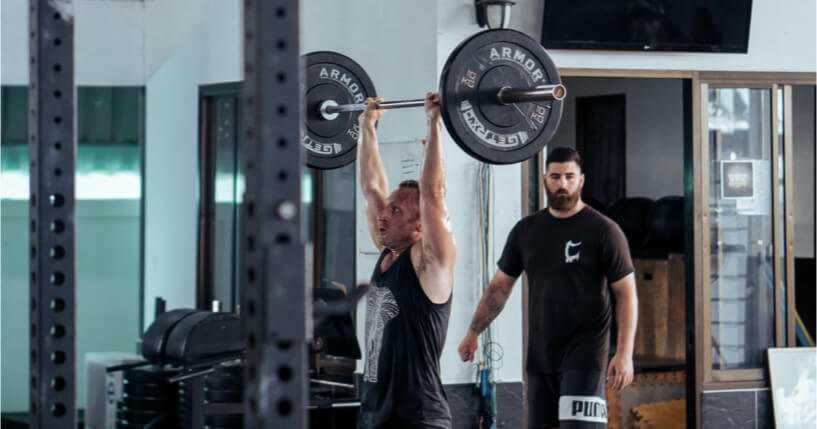

Muscles trained: Medial and anterior deltoids, upper chest, triceps, and core.
Equipment: Dumbbells or a barbell
- Position the barbell at collarbone height. Grab it evenly with your hands roughly shoulder-width apart. Make sure your thumbs envelop the barbell, too.
- Tuck yourself underneath the barbell with a staggered stance, take a breath, and push up to unrack it.
- Take a couple of steps back to clear enough room with the barbell near your upper chest.
- Take another breath and push through your elbows until the barbell is above your head and your arms are straight. Exhale as you slowly bring the barbell back to the starting position.
Popular Beginner Exercises for Upper Body Workouts
Lat Pulldown
Lat pulldowns are a fantastic accessory movement that helps you further develop your back and improve its width. It is an excellent exercise to add to a beginner’s upper body workout.
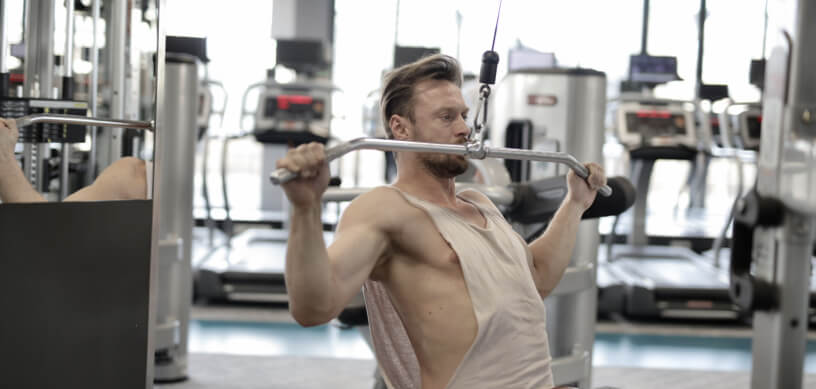

Muscles trained: Lats, rhomboids, biceps, and forearms.
Equipment: Lat pulldown machine
- Set the appropriate weight, grab the bar evenly with a grip slightly outside shoulder width with palms facing away from the body and sit down.
- Make sure your thighs fit snugly underneath the machine’s pads.
- Bring your chest out and shoulders back, take a breath and pull the bar down to your upper chest.
- Pull until the bar taps your upper chest and release it slowly until your arms straighten.
Triceps Rope Pushdown
The rope pushdown is a humbling and incredibly effective exercise you can do to strengthen and develop your triceps.
_Upper-Arms_small.jpg)
_upper-arms_small.jpg)
Muscles trained: Triceps
Equipment: Cable station and rope attachment
- Start with a lighter weight and grab the rope attachment near the bottom with both hands.
- Keep your elbows bent and to your side as you take a step or two back to lift the weight off the stack.
- Bring your shoulders back, take a breath, and extend your elbows as you bring your hands down and to your sides, splitting the rope.
- Hold for a moment as your elbows extend fully and slowly release the weight to the starting position.
Shoulder Press (Dumbbell)
The dumbbell shoulder press is a great compound movement for building shoulder strength and mass.
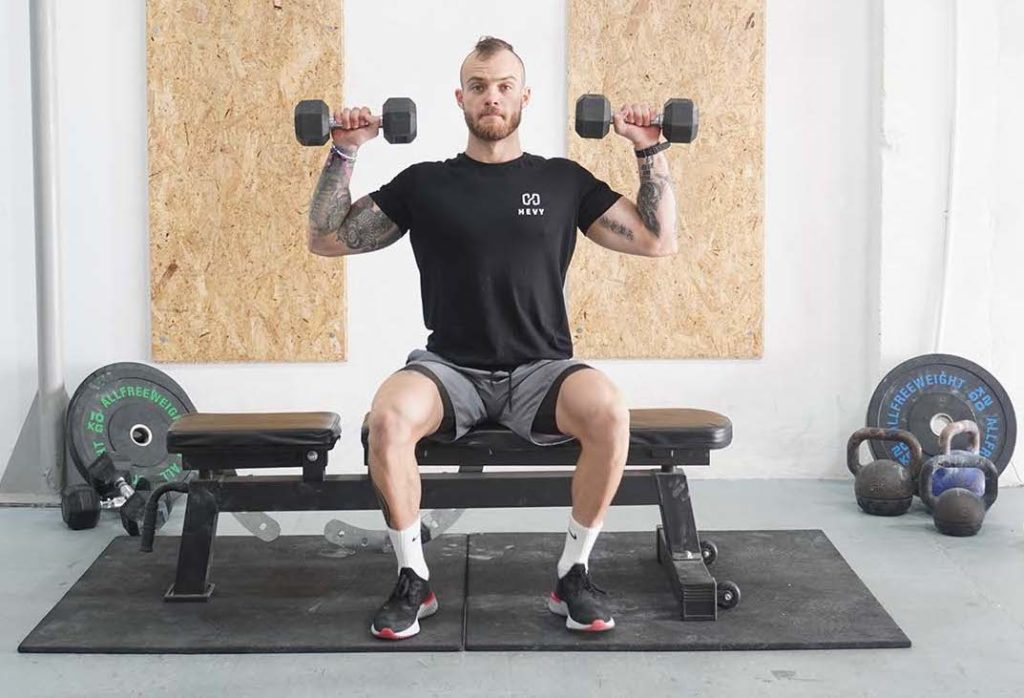

Muscles trained: Medial and anterior shoulder heads, triceps, and upper chest
Equipment: An adjustable flat bench and dumbbells
- Adjust the bench to 90 degrees, take a dumbbell in each hand, and sit down.
- With your back against the bench, bring both dumbbells atop your thighs, and get your shoulders back.
- Take a breath and use your leg strength to hoist the dumbbells to your sides one at a time.
- Take a breath and push through your triceps and shoulders to bring the weights over your head.
- Slowly lower them to your sides as you exhale.







Hevy – Workout Tracker
Create your own chest workouts with Hevy, and track your progress.







Hevy – Workout Tracker
Create your own chest workouts with Hevy, and track your progress – for free.
Incline Bench Press
The incline press is an important assistance exercise for your chest because it helps emphasize the clavicular (upper) head and contributes to fully developed pectorals.
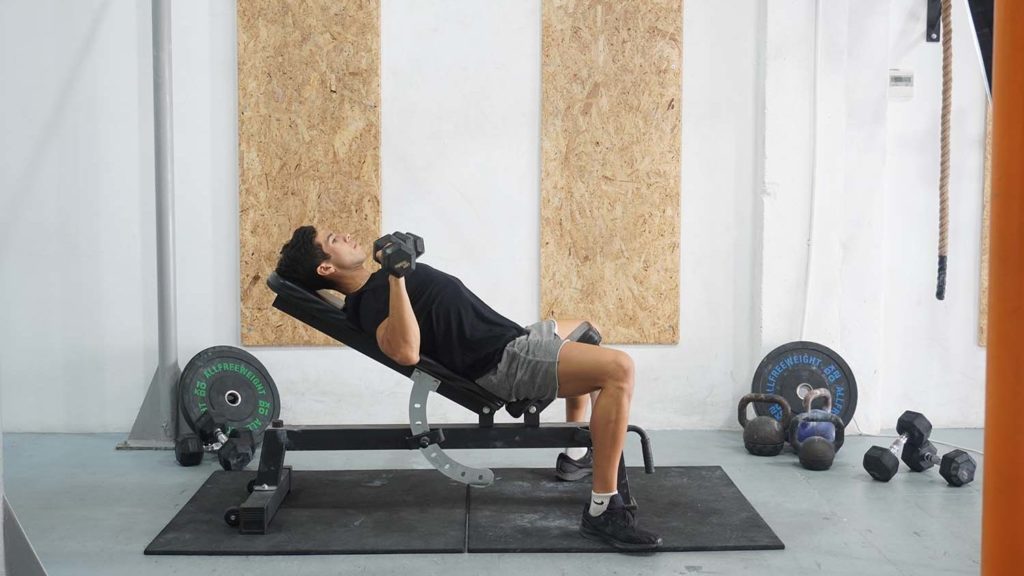
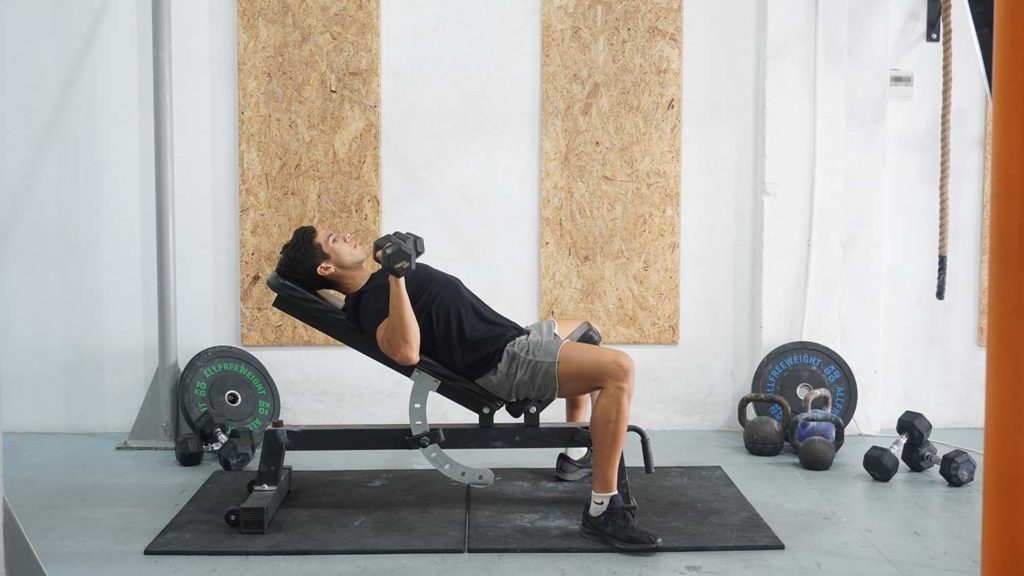
Muscles trained: Upper chest, medial and anterior shoulder heads, and triceps.
Equipment: Adjustable or incline bench and barbell or dumbbells
- Adjust the bench to anywhere from 30 to 45 degrees, take a dumbbell in each hand, and sit down.
- Curl both dumbbells and rest them on top of your thighs.
- Use your leg strength to hoist both dumbbells up over your torso as you simultaneously lie down on the bench.
- With both dumbbells over your chest and arms straight, take a breath, and bend your elbows gradually until you feel a stretch on your chest muscles.
- Push through to bring both dumbbells back to the starting position as you exhale.
Hammer Curls
The hammer curl is a variation of the traditional movement that offers great bicep development while also strengthening the forearms.
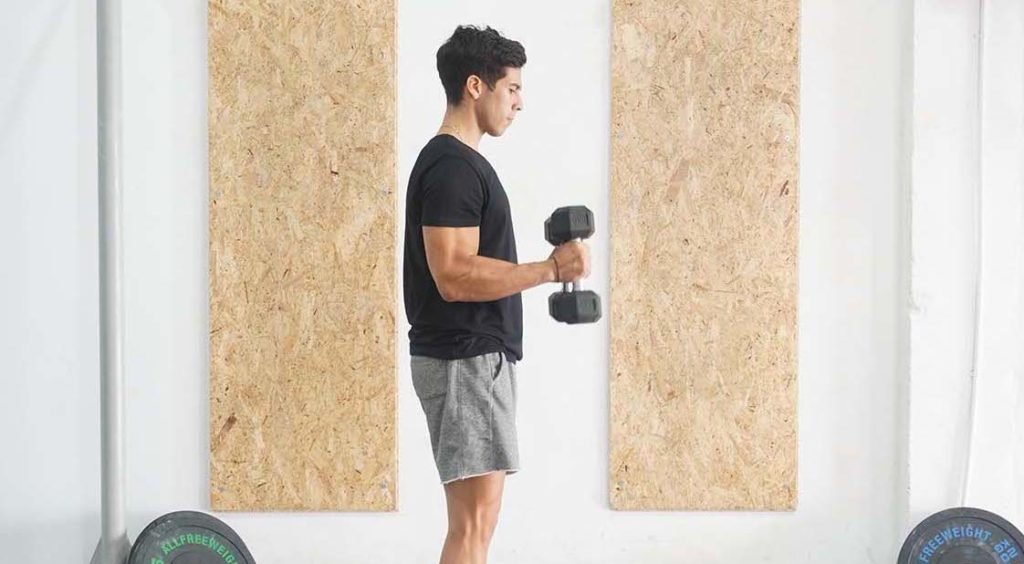

Muscles trained: Biceps and forearms
Equipment: Dumbbells
- Take a dumbbell in each hand, and stand tall. With your arms to your sides and palms facing your body, bring your shoulders back and take a breath.
- Curl both dumbbells without changing your wrist position until your hands are slightly higher than your elbows.
- Hold the top position for a moment and slowly release both dumbbells to the starting position as you exhale.
Seated Cable Rows
The seated cable row is an excellent assistance exercise that adds strength and thickness to your back musculature.


Muscles trained: Lats, rhomboids, erector spinae, trapezius, biceps, and forearms.
Equipment: A seated cable row machine
- Adjust the weight of the machine and sit down.
- Grab the handle with both hands, place your feet on the machine’s platform, and bring yourself back to lift the weight off its stack.
- Bring your shoulders back, take a breath, and row the handle toward your upper stomach.
- As the handle taps your belly, hold it for a moment, and release it gradually while exhaling.
Skull Crushers
Despite their unnerving name, skull crushers are an excellent tricep movement that does a fantastic job emphasizing the long head and building up your strength.


Muscles trained: Triceps and shoulders
Equipment: A straight or EZ bar
- Grab a bar, lift it in front of your chest, and carefully sit down on a flat bench.
- In one motion, lie on the bench slowly as you extend your elbows so the bar ends up over your face.
- Bring your shoulders back and take a breath.
- Bend your elbows as you allow the bar to travel down and back behind your head. Lower as much as you can – you should feel a nice stretch in your tricep.
- Extend your elbows and bring the bar over your head as you exhale.
Face Pulls
Face pulls are a simple and beneficial exercise you should do regularly to develop your rear deltoids and maintain good shoulder health.


Muscles trained: Rear deltoids, trapezius, and biceps
Equipment: A resistance band or cable station with a rope
- Attach a rope to a high pulley, grab it with both hands with palms facing down, and take a couple of steps back.
- With your elbows straight and up, bring your chest back, and take a breath.
- Make sure your thumbs face the ceiling and pull the rope toward your face, at roughly eye level.
- Exhale as you slowly release the weight and extend your arms.
Push-Ups
Push-ups are a versatile and incredibly useful bodyweight movement that strengthens and develops your chest, shoulders, triceps, and serratus anterior.


Muscles trained: Chest, anterior deltoids, triceps, and serratus anterior
Equipment: Push-up stands (optional)
- Get down on all fours and place your hands flat on the floor, slightly wider than shoulder level.
- Make sure your elbows are somewhat tucked in and not flared out.
- Lift your knees and balance your lower body on your toes. Straighten your body so your shoulders, hips, and feet are in a straight line.
- Take a breath and bend your elbows gradually. Go down as comfortably as you can – ideally until your nose almost touches the floor.
- Push through your elbows to lift your body as you exhale.
2 Beginner Upper Body Workouts
The premise behind any good upper body workout is to combine the right exercises and train the right muscle groups together. First, it’s beneficial to combine muscle groups that work well together.
Examples include:
– Triceps with chest
– Chest with shoulders
You can also have fantastic upper body workouts that train all of the major muscle groups together. But, if your goal is to have somewhat shorter workouts, you should adhere to the above combinations.
Second, it’s important to structure each workout effectively for optimal performance and the best possible stimulus. Start your workouts with compound movements and gradually move down to accessory lifts and isolation exercises.
1. Upper Body Workout for Beginners (All Upper Body)
| Bench Press (Barbell) | 3 sets of 8 to 12 reps |
| Bent Over Row (Barbell) | 3 sets of 8 to 12 reps |
| Shoulder Press (Dumbbell) | 2 sets of 8 to 15 reps |
| Lat Pulldown (Cable) | 2 sets of 12 to 15 reps |
| Hammer Curl (Dumbbell) | 2 sets of 12 to 20 reps |
| Triceps Rope Pushdown | 2 sets of 12 to 20 reps |
| Face Pull | 2 sets of 15 to 30 reps |
Click here to find and track this workout on the Hevy app.
2. Kettlebell Upper Body Workout for Beginners
| Kettlebell Shoulder Press | 3 sets of 8 to 12 reps |
| Kettlebell High Pull | 3 sets of 8 to 12 reps |
| Kettlebell Chest Press | 3 sets of 8 to 12 reps |
| Kettlebell Swing | 3 sets of 12 to 15 reps |
| Kettlebell Curl | 2-3 sets of 12 to 20 reps |
Click here to find and track this workout on the Hevy app.
Beginner Workout Plans Containing Upper Body Workouts
Upper Lower Plan
The upper lower split is among the most popular ways to organize your training. A common way to program it is to have four weekly workouts – two upper and two lower.
Monday – Upper
Tuesday – Lower
Wednesday – Off
Thursday – Upper
Friday – Lower
Saturday & Sunday – Off

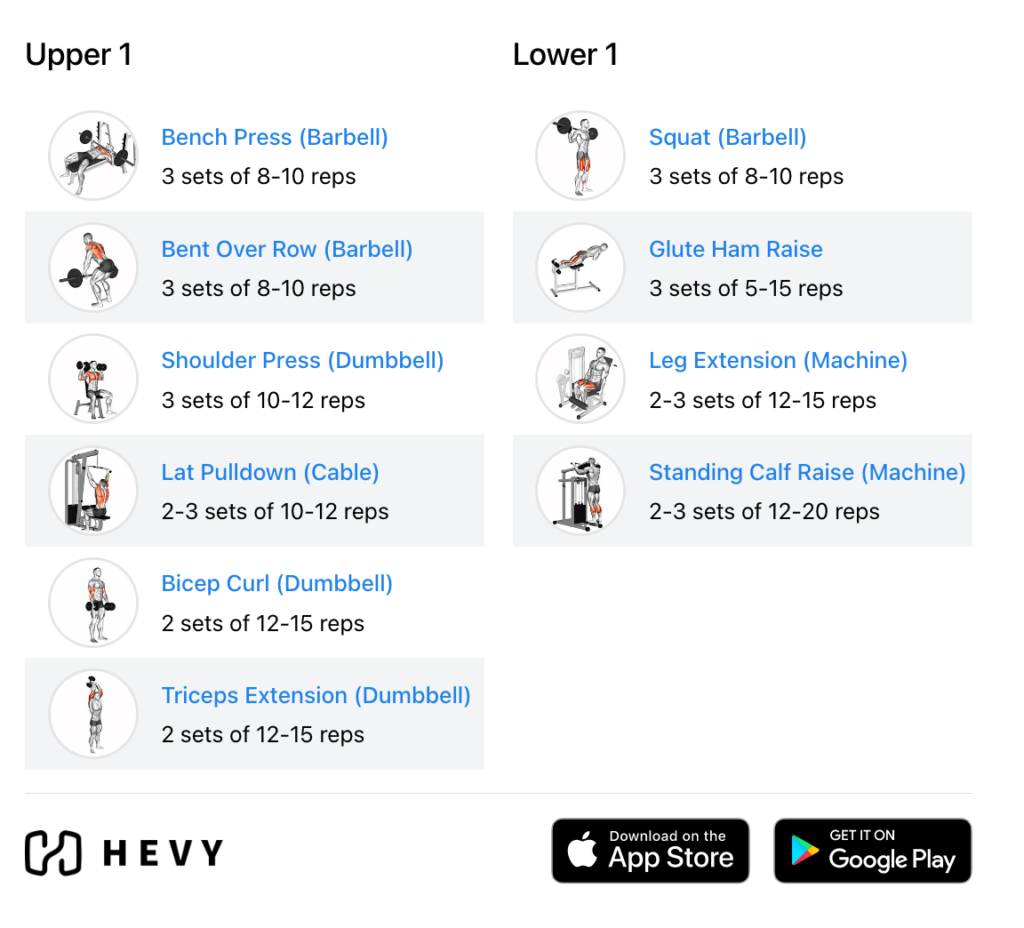


With this schedule, you have two upper-body workouts each week. The goal is to train all major muscle groups twice per week, which appears optimal for hypertrophy (7). If you download Hevy, you’ll see some pre-built Upper / Lower workouts you can use for free.
As far as workout structure goes, you should typically start one of your upper workouts with a pushing movement (such as a flat or overhead press) and the other with a pull (such as a pull-up or barbell row). Alternate between exercises for your chest and back and introduce assistance and isolation movements for your shoulders, biceps, triceps, abs, and lower back as your workout progresses.
A workout plan like Push Pull Legs (PPL) will also segment your upper body training in an efficient way.
3 Day Split (Like Bro Split)
Three-day splits are similar to the classic bro split. The goal is to spread your training volume across three unique workouts, which is beneficial for giving your muscles enough time to recover. Plus, this type of training program is suitable if you’re pressed for time and can’t dedicate more than three days each week to working out.
Day 1 – Chest, shoulders, and triceps (Upper body)
Day 2 – Back and biceps
Day 3 – Legs and abs


The good thing about this split is that you get to train all of the major muscle groups in your body. It’s also good for preventing too much overlapping volume where you use a muscle group in one workout and then have to train it the very next day.
Inside this structure, you split your upper body training into two workouts: one focuses on pushing movements and one on pulling. The workout structure is similar to the one you would have for any other split. You start your workouts with compound movements like the bench press and pull-up and gradually move to assistance and isolation movements like chest flyes, bicep curls, and lateral raises.
Benefits of Having a Strong Upper Body
1. It Makes You Capable and Independent
The most notable benefit of upper body strength is that you’re more capable of doing everyday activities without needing assistance. Things like carrying groceries, moving furniture, and lifting your child all become easier. This is also fantastic because you get to be more independent and don’t have to rely on others’ help for somewhat challenging activities.
Plus, research finds a positive correlation between physical strength and quality of life in elderly individuals (5).
2. It Improves Your Posture And Keeps Nagging Aches at Bay


Poor posture can stem from many things, and we sometimes need a professional’s assistance to resolve such an issue. But, in many cases, healthy individuals suffer from poor posture precisely because of weak and tight muscles. Specifically, tight muscles in the front (chest and shoulders) and weak muscles in the back (lats, rhomboids, trapezius, etc.) (3, 4). There are many exercises that you can do to keep your back muscles strong.
Developing upper body strength is great for your posture precisely because it addresses the issue of the back musculature. Strengthening these muscles will keep your spine in a natural position and prevent your shoulders from rolling forward.
3. It Simply Feels Good
Whether we like to admit it or not, we train to feel better about ourselves, and there is nothing wrong with that. Having a stronger upper body, reaching new goals, and setting personal records are all rewarding things. With Hevy, you can easily see when you set personal records and improve over time. With each passing workout, you feel better knowing that you’re more capable.







Hevy – Workout Tracker
Create your own chest workouts with Hevy, and track your progress.







Hevy – Workout Tracker
Create your own chest workouts with Hevy, and track your progress – for free.
Plus, this can be incredibly valuable if you’re a competitive person and enjoy doing better than your friends; compare exercises on Hevy!
Conclusion
Upper body workouts are those that bundle several muscle groups and have you train them together. These can include your core, chest, back, shoulders, biceps, triceps, forearms, and traps.
Upper body training is essential because it contributes to your overall fitness, helps you become more athletic, and allows you to do more and remain independent.
As far as workout structure goes, putting together effective workouts is not a big deal. All you have to do is follow some basic rules, be mindful of the overall layout, and learn how to sequence exercises. As you saw above, you have two fantastic ways to organize upper body workouts for beginners into a training week.
First, you can use an upper lower plan to train your upper body anywhere from one to three times per week. Second, you can go for the simpler three-day routine that splits your upper body musculature into two workouts.
As always, thanks for reading! If you need any help with tracking your workouts, using an app like Hevy can help to structure them and visualize progress.
FAQ
1) What is a good upper body workout?
A good upper body workout allows you to train a large percentage of your upper body musculature, gets you to do enough training volume, and includes various movements for the target muscle groups (8, 9).
2) How can I work out my upper body at home?
Training your upper body at home is not as difficult as many people imagine. Movements like pull-ups and chin-ups, push-ups, chair dips, planks, handstands, crunches, pike push-ups, and burpees are all excellent ways to train the majority of your upper body musculature (10).
3) How long should my workouts be?
The goal of your training shouldn’t be to set a timer and try to fit within a given time frame. Instead, you should do all of your sets and repetitions, go down your list of exercises, and rest well between sets (11, 12). No single workout should be much longer than an hour for the average person, especially if they train more often.
4) How long should I rest between upper body workouts?
Research finds that muscle protein synthesis tends to drop within around 36 to 48 hours of training, and this is a guideline to follow when organizing your upper body training (13). Of course, this can vary based on the length and difficulty of your workouts, your fitness level, your schedule, and goals. For most people, two upper body workouts per week will be the sweet spot. Rest a couple of days between the two, and you’ll do great.







